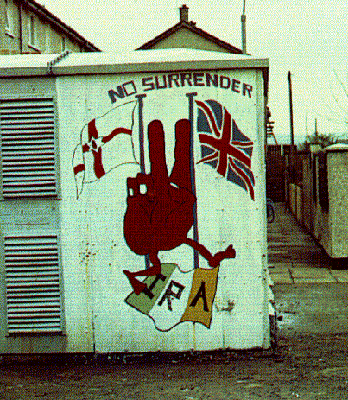 CAIN Web Service
CAIN Web Service
Drawing Support: Murals in the North of Ireland
Loyalist Mural - Red Hand of Ulster
[CAIN_Home]
[Key_Events]
[Key_Issues]
[Conflict_Background]
Text and Photograph: Bill Rolston ... Page Compiled: Fionnuala McKenna
Theme
Red Hand of Ulster and various flags.
The Red Hand of Ulster is a traditional symbol of the
O'Neill clan, the major clan in the northern part of Ireland up
to the time of the Plantation, early 17th century. The
Plantation was in fact a strategic move on the part of the Elizabethans
to undermine the power of the O'Neills in the area. The
symbol derives from a myth of two chieftans rowing in separate
boats towards a shore. Their agreement is that the one who
touches the shore first may claim the land as his kingdom. The
losing chieftan cut off his hand and threw it ahead of the
winning boat, thus claiming the land. Thus, traditionally the symbol
is that of an open and upright right hand dripping blood. It is
reworked by the Loyalist Prisoners' Association, shown wrapped
in barbed wire, the ultimate insult to loyalists "whose only crime
was loyalty". Sometimes it is shown as a fist, a symbol of
power, in murals supporting the UFF, Ulster Freedom Fighters, the
nom de guerre of the Ulster Defence Association. Here, the Red
Hand has sprouted feet and dances derisively on the Irish
tricolour, which also bears the initials of the IRA, Irish Republican
Army. The mural is a response to the signing of the Anglo-Irish
Agreement in November 1985, when the governments in Dublin and
London agreed to consult each other over matters pertaining to
Northern Ireland.
Location and Date
Tullevin Drive, Newtownabbey, near Belfast, 1988

Return to List of Murals
|

